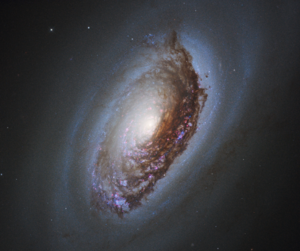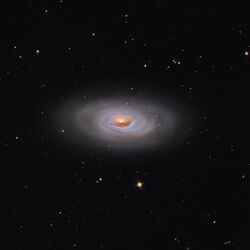Astronomy:Black Eye Galaxy
| Black Eye Galaxy[1] | |
|---|---|
 Image taken by Hubble Space Telescope, March 14, 2020 | |
| Observation data (J2000 epoch) | |
| Constellation | Coma Berenices[2] |
| Right ascension | 12h 56m 43.696s[3] |
| Declination | +21° 40′ 57.57″[3] |
| Redshift | 0.001361±0.000013[4] |
| Helio radial velocity | 410[5] |
| Galactocentric velocity | 400±4[6] |
| Distance | 17.3 Mly (5.30 Mpc)[5] |
| Group or cluster | CVn I[7] |
| Apparent magnitude (V) | 8.52[8] |
| Apparent magnitude (B) | 9.36[8] |
| Characteristics | |
| Type | (R)SA(rs)ab,[4] HIISy2 |
| Size | 16.51 kiloparsecs (53,800 light-years) (diameter, 25.0 mag/arcsec2 B-band isophote)[9] |
| Apparent size (V) | 10.71 × 5.128 arcminute[10] |
| Other designations | |
| Evil Eye Galaxy, M64, NGC 4826, PGC 44182, UGC 8062[10] | |
The Black Eye Galaxy (also called Sleeping Beauty Galaxy or Evil Eye Galaxy and designated Messier 64, M64, or NGC 4826) is a relatively isolated[7] spiral galaxy 17 million light-years away in the mildly northern constellation of Coma Berenices. It was discovered by Edward Pigott in March 1779, and independently by Johann Elert Bode in April of the same year, as well as by Charles Messier the next year. A dark band of absorbing dust partially in front of its bright nucleus gave rise to its nicknames of the "Black Eye", "Evil Eye", or "Sleeping Beauty" galaxy.[11][12] M64 is well known among amateur astronomers due to its form in small telescopes and visibility across inhabited latitudes.
This galaxy is inclined 60° to the line-of-sight and has a position angle of 112°.[7] At the distance of this galaxy, it has a linear scale of 65 ly (20 pc) per arcsecond.[7] The morphological classification in the De Vaucouleurs system is (R)SA(rs)ab,[4] where the '(R)' indicates an outer ring-like structure, 'SA' denotes a non-barred spiral, '(rs)' means a transitional inner ring/spiral structure, and 'ab' says the spiral arms are fairly tightly wound.[13] Ann et al. (2015) gave it a class of SABa,[14] suggesting a weakly barred spiral galaxy with tightly wound arms.
M64 is a type 2 Seyfert galaxy[15] with an HII/LINER nucleus. The central region is a weak source of radio emission.[7] A soft X-ray source has been detected at the nucleus, which is most likely coming from the circumnuclear region rather than directly from an active galactic nucleus.[16] There is an inner disk of molecular gas that is truncated at a radius of 2,300 ly (700 pc). At present, the non-rotational motions of this disk do not significantly feed the core, but the disk does produce a vigorous rate of star formation, with also approximately 100 billion stars inside the galaxy.[11] There is also evidence of a recent large inflow of mass.[17]
The interstellar medium of Messier 64 consists of two counter-rotating disks that are approximately equal in mass.[18] The inner disk contains the prominent dust lanes of the galaxy. The stellar population of the galaxy exhibits no measurable counter-rotation.[19] Possible formation scenarios include a merger with a gas-rich satellite galaxy in a retrograde orbit, or the continued accretion of gas clouds from the intergalactic medium.[18][19] It has a diameter of 16.51 kiloparsecs (53,800 light-years).[9]
See also
- List of Messier objects
- NGC 4622 – A galaxy with leading spiral arms.
References
- ↑ Tonry, J. L. et al. (2001), "The SBF Survey of Galaxy Distances. IV. SBF Magnitudes, Colors, and Distances", Astrophysical Journal 546 (2): 681–693, doi:10.1086/318301, Bibcode: 2001ApJ...546..681T.
- ↑ Dreyer, J. L. E. (1988), Sinnott, R. W., ed., The Complete New General Catalogue and Index Catalogue of Nebulae and Star Clusters, Sky Publishing Corporation/Cambridge University Press, ISBN 978-0-933346-51-2.
- ↑ 3.0 3.1 Skrutskie, Michael F.; Cutri, Roc M.; Stiening, Rae; Weinberg, Martin D.; Schneider, Stephen E.; Carpenter, John M.; Beichman, Charles A.; Capps, Richard W. et al. (1 February 2006). "The Two Micron All Sky Survey (2MASS)". The Astronomical Journal 131 (2): 1163–1183. doi:10.1086/498708. ISSN 0004-6256. Bibcode: 2006AJ....131.1163S.
- ↑ 4.0 4.1 4.2 de Vaucouleurs, G. et al. (1991), Third reference catalogue of bright galaxies, 9, New York: Springer-Verlag.
- ↑ 5.0 5.1 Tully, R. Brent et al. (August 2016), "Cosmicflows-3", The Astronomical Journal 152 (2): 21, doi:10.3847/0004-6256/152/2/50, 50, Bibcode: 2016AJ....152...50T.
- ↑ "NASA/IPAC Extragalactic Database", Results for NGC 4826, http://ned.ipac.caltech.edu/cgi-bin/objsearch?objname=m64&extend=no&hconst=73&omegam=0.27&omegav=0.73&corr_z=1&out_csys=Equatorial&out_equinox=J2000.0&obj_sort=RA+or+Longitude&of=pre_text&zv_breaker=30000.0&list_limit=5&img_stamp=YES, retrieved 2018-12-13.
- ↑ 7.0 7.1 7.2 7.3 7.4 Israel, F. P. (January 2009), "CI and CO in nearby galaxy centers. The bright galaxies NGC 1068 (M 77), NGC 2146, NGC 3079, NGC 4826 (M 64), and NGC 7469", Astronomy and Astrophysics 493 (2): 525–538, doi:10.1051/0004-6361:200810655, Bibcode: 2009A&A...493..525I.
- ↑ 8.0 8.1 Gil de Paz, Armando et al. (2007), "The GALEX Ultraviolet Atlas of Nearby Galaxies", Astrophysical Journal Supplement Series 173 (2): 185–255, doi:10.1086/516636, Bibcode: 2007ApJS..173..185G.
- ↑ 9.0 9.1 "Your NED Search Results". https://ned.ipac.caltech.edu/cgi-bin/objsearch?objname=2MASX+J13250547-2014151&extend=no&hconst=67.74&omegam=0.3089&omegav=0.6911&corr_z=1&out_csys=Equatorial&out_equinox=J2000.0&obj_sort=RA+or+Longitude&of=pre_text&zv_breaker=30000.0&list_limit=5&img_stamp=YES.
- ↑ 10.0 10.1 "M 64". SIMBAD. Centre de données astronomiques de Strasbourg. http://simbad.u-strasbg.fr/simbad/sim-basic?Ident=M+64.
- ↑ 11.0 11.1 "Messier 64 - M64 - Black Eye Galaxy (Spiral Galaxy) | freestarcharts.com". https://freestarcharts.com/messier-64.
- ↑ Rubin, Vera C. (January 1994). "Kinematics of NGC 4826: A sleeping beauty galaxy, not an evil eye". The Astronomical Journal 107: 173. doi:10.1086/116842. ISSN 0004-6256. Bibcode: 1994AJ....107..173R.
- ↑ de Vaucouleurs, Gérard (April 1963), "Revised Classification of 1500 Bright Galaxies", Astrophysical Journal Supplement 8: 31, doi:10.1086/190084, Bibcode: 1963ApJS....8...31D.
- ↑ Ann, H. B. et al. (2015), "A Catalog of Visually Classified Galaxies in the Local (z ~ 0.01) Universe", The Astrophysical Journal Supplement Series 217 (2): 27–49, doi:10.1088/0067-0049/217/2/27, Bibcode: 2015ApJS..217...27A.
- ↑ Malkan, Matthew A. et al. (September 2017), "Emission Line Properties of Seyfert Galaxies in the 12 μm Sample", The Astrophysical Journal 846 (2): 26, doi:10.3847/1538-4357/aa8302, 102, Bibcode: 2017ApJ...846..102M.
- ↑ Grier, C. J.; Mathur, S.; Ghosh, H.; Ferrarese, L. (April 2011), "Discovery of Nuclear X-ray Sources in Sings Galaxies", The Astrophysical Journal 731 (1): 13, doi:10.1088/0004-637X/731/1/60, 60, Bibcode: 2011ApJ...731...60G.
- ↑ García-Burillo, S. et al. (August 2003), "Molecular Gas in NUclei of GAlaxies (NUGA). I. The counter-rotating LINER NGC 4826", Astronomy and Astrophysics 407 (2): 485–502, doi:10.1051/0004-6361:20030866, Bibcode: 2003A&A...407..485G.
- ↑ 18.0 18.1 Brawn, R.; Walterbos, R. A. M.; Kennicutt, Robert C. Jr. (1992). "Counter-rotating gaseous disks in the "Evil Eye" galaxy NGC4826". Nature 360 (6403): 442. doi:10.1038/360442a0. Bibcode: 1992Natur.360..442B.
- ↑ 19.0 19.1 Rix, Hans-Walter R.; Kennicutt, Robert C. Jr.; Walterbos, Rene A. M. (1995). "Placid stars and excited gas in NGC 4826". Astrophysical Journal 438: 155. doi:10.1086/175061. Bibcode: 1995ApJ...438..155R.
External links
- Messier 64, SEDS Messier pages
- ESA/Hubble images of M64
- NASA Astronomy Picture of the Day: M64: The Black Eye Galaxy (2 August 2007)
- The Black Eye Galaxy on WikiSky: DSS2, SDSS, GALEX, IRAS, Hydrogen α, X-Ray, Astrophoto, Sky Map, Articles and images
- a real photo by Pete Albrecht
- Black Eye Galaxy (M64) at Constellation Guide
Coordinates: ![]() 12h 56m 43.7s, +21° 40′ 58″
12h 56m 43.7s, +21° 40′ 58″
 |



